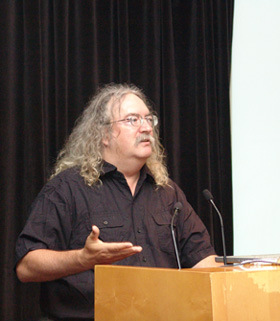Conference by Stephen Downes at the First International Conference Free Knowledge, Free Technology – Education for a free information society in Barcelona (Spain), 17 July 2008, on the production and sharing of free educational and training materials about Free Software.
Stephen Downes, Institute for Information Technology‘s Internet Logic Research Group
The Future of Education
The Public in Public Education
Public education, education for everyone, is an important concept not for the “education” part, but for the “public” part, as its impact goes far beyond the acquisition of knowledge, but the shaping of the whole society.
Stephen Downes presents gRSShopper. Besides the most evident uses of the tool as a resource harvester, the main purpose being connecting the different resources amongst them, to link one to each other different pieces of content scattered around the Internet. This is a personal learning environment
, more than a social software intended to build community; an personal environment but headed to openly being a part of the network of people and content.
Freedom
Freedom as a state of being: putting the stress on the personal capability and will to do something, more than e.g. on the formal or legal permission to.
Freedom is an attitude, a perspective of self-determination, of self-government, to be what you want to be
. Education means realizing the degree of freedom you’re in and finding out the way to get more of that freedom. But being educated does not suffice, as practical constrains (fear, etc.) also apply.
Freedom is also about being able to reach one’s own potential.
Freedom as access: access to knowledge and learning, where these are public goods, created in a nonprofit way that expects no revenue from their creation and distribution.
The Future of Education
The concept of the “class” is an administrative one, not related with pedagogy, not related with a course. But the question is that, for several (socialization) reasons, the idea of the “class” sticks. But could the network substitute the group? Communication is central to our being, so our connections do shape ourselves and our actions.
So there’s pressures towards using our natural connections to engage in collective learning, more than to move into an artificially built classroom that, even if it might have been an efficient tool in the past, it only seems now to be perpetuating relationships of power between teachers and learners.
Competences
Competences are a dynamic concept, based on growth. And they require a constantly changing path that can be filled with different (ad hoc) educational recourses.
Nevertheless, there is learning hardly identifiable with competences.
So, competences should be one more way to identify learning opportunities, and the selection of learning resources just an add-on to a whole system of learning activities (traditional and new ones).
The selection of learning options should depend on our background and framework (former learning, actual legislation, etc.) and should be driven also by context, by actual needs.
Delivery systems
We have, hence, to build topic delivery systems, systems that deliver learning resources.
Delivery systems today are, basically, content delivery systems. The Personal Learning Environment (PLE) is here to replace learning management/delivery systems. The PLE is more a concept than an application:
- Is based on the idea of personal access to resources from multiple sources
- Is based on a personal web presence
- Focuses on creation and communication rather than on content completion
Education should be no more as managing a system, but delivering in a network; no more something self-contained, closed, but something interacting with a larger environment. Thus, educational institutions have to reshape themselves to become entities that interact with the larger environment.
Connectivism and Freedom
Our ideas of concepts are created through “wholes” of information sets — the basis of Connectivism. So educational institutions have to make resources available to both contribute and be able to build these “wholes”. The resources have to be able to learn from the environment and the student, and communicate with their framework and environment. Among other things, this will make personalization more efficient.
Education should be a flat network, where both students and teachers are nodes communication one to each other. And the communications among these nodes should be free: if these communications are mediated (or just made possible) by digital resources, these resources need to be free to enable communication… and hence education.
Al Gore, The assault on reason: we’ve gone from a society that used to think by itself to a society that is being though for itself (e.g. media think for the society). We have to go back to the society that used to think for itself. And content needs to be free to be able to reach this state of freedom of communication and thought.
The market — and their firms — are putting barriers to these freedoms. And, indeed, non-commercial licenses (cc-sa, copyleft) allow bad practices against the free flow of content, as they do not prevent perverse uses of open resources.
The role of public education institutions should be, in the end, to promote this free flow of resources. To guarantee access to the public good that is digital content and media as the language of interaction today.
